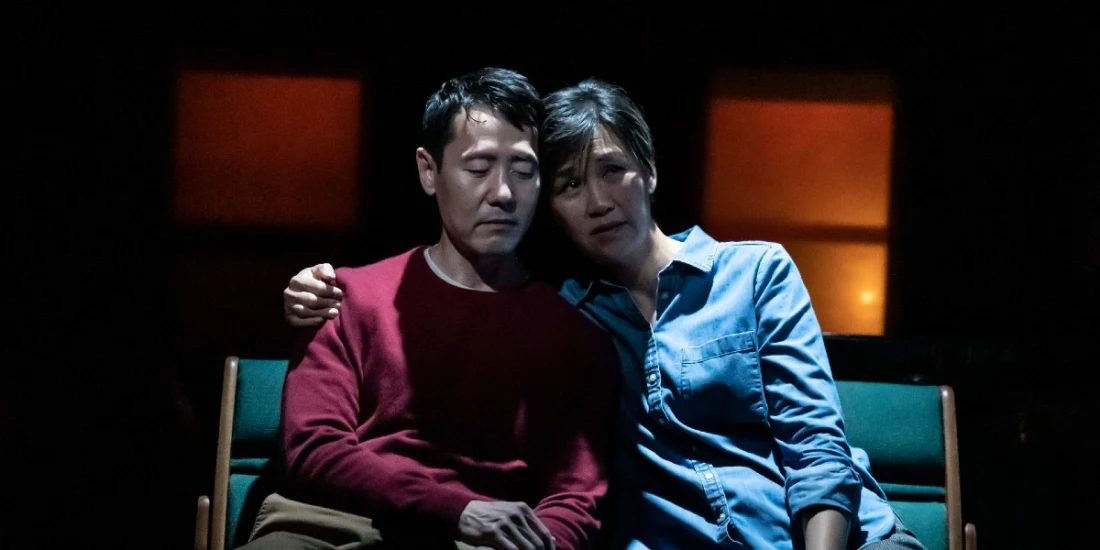'Catch as Catch Can' review — expertly acted play turns the family drama on its head
Unhappy families are unhappy in their own way, so it’s long been said. In her conceptually ambitious and expertly acted play, Catch as Catch Can, Mia Chung takes that time-honored trope and puts her own theatrical stamp on it. Bottom line, she doubles down.
Three actors play six characters – each an adult child and one of their parents — jumping genders and generations while they’re at it. In director Daniel Aukin’s staging at Playwrights Horizons, a trio of Asian actors play the characters who, the script notes, are white. This production uses a newly revised script following a Page 73 presentation in 2018.
We meet the Italian American Lavecchias and the Irish American Phelans, working-class New England neighbors. At lights up Theresa Phelan (Rob Yang) and Roberta Lavecchia (Jon Norman Schneider) sip tea and gab about the far-off royal family before turning their attention to their own. Theresa’s son Tim (Yang) is back from California and he's engaged – to Mingjin, a Korean-American architect.
Roberta’s son Robbie (Schneider), who lives with his folks, is still reeling from a divorce from his Chinese wife. Meanwhile, Roberta’s daughter Daniela (Cindy Cheung, who also plays her father, Lon), appears to be eagerly anticipating her boyfriend’s proposal.
The next 14 scenes, separated by blackouts, show how just about everything that appeared to be true in that first exchange isn’t, thanks to misinterpretations or flat-out deceptions.
It begs the question: Can you ever really know somebody and trust what they’re saying? Or, for that matter, oneself? Deep into the play Chung spells this out explicitly when Tim asks Robbie: “D’you know who you are … d’you like who you are? … I’ve no idea who I am.”
Parent-child doubling automatically sets the stage for blurred lines and potentially meaty meditations on personal identity, ancestry, and how apples don’t – and do – fall far from the tree when it comes to ingrained attitudes. Chung’s casting concept doesn’t break new ground, but she’s created six distinct characters who are fun to hang out with – until they’re not.
An abrupt shift occurs roughly midway into this 105-minute, intermission-free presentation. That’s the moment Tim shares a disturbing revelation about Mingjin with Daniela that changes everything about how other characters – and the audience – respond to him.
It also changes the tenor of the play from mostly easygoing and light and to sobering and sad. Sure, families can turn on a dime. But at this point, the story’s focus on a man bent on self-harm is what’s significant, not casting conceits.
Through it all, the actors prove themselves marvelous multitaskers as they toggle between their roles – sometimes in the blink of an eye. An extended scene wrapped around a Christmas gathering is a prime example of skillful shifting. Thanks to their deft and distinct characterizations, we always know exactly who’s who.
Less clear is just how much Chung’s story gains from the dual casting. In terms of this all-Asian cast, an ethnically charged exchange about Mingjin between Roberta (“They’re built different”) and Theresa (“She’s like a little doll”) lands with more sting because of it.
Is Catch as Catch Can more interesting and satisfying for the actors than for the audience? Mileage may vary. Still, watching actors instantly become other people without any physical change or costume shift reminds that theatre allows us to tell stories in a way that can’t be done elsewhere.
Photo credit: Rob Yang and Cindy Cheung in Catch as Catch Can. (Photo by Joan Marcus)
Originally published on
